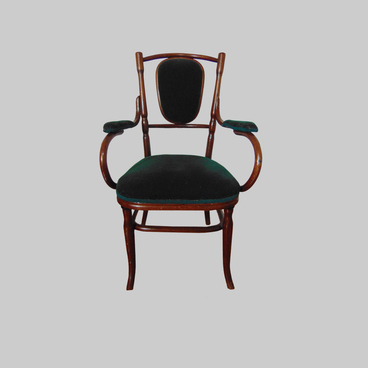The furnishing of the ‘Large sitting room’ of the Aksakov family museum reflects the aesthetics of the late 19th and early 20th centuries. Back then, electrical appliances were only just beginning to spread, so in addition to the chandelier on an old Schröder piano, in the living room stand two candlesticks made in the early 20th century. They are cast from a yellow metal, with a carved foot on a stand and a candle hollow.
Candlesticks, like any other interior components, changed after the innovations of the era, both intellectual and technological kind. Historically, their appearance was most often quite modest, usually in the form of a carved baluster – a short figure in the shape of a pillar. However by the 19th century, with industrial production and, consequently, industrial design flourishing, candlesticks were often manufactured in increasingly peculiar and fanciful shapes, and many houses were beginning to feature bronze varieties with figurines. The candlesticks, represented in ‘Big Living Room’ exposition, are rather conservative in shape, with only the unusual layered leg standing out.
The first candlesticks appeared in the Etruscan culture in the 12th-11th centuries BC. Around the same time in ancient Egypt, there existed a myth about the birth of the sun god Ra, allegedly born from a lotus flower on a hill. According to the legend, Ra defeated the darkness, saved people from the fear of night and brought light. There were similar myths widely spread in other cultures as well. They are believed to be the primary reason for why many of the light sources were stylized in the form of a flower.
Since ancient times, candlesticks of all kinds usually had a stand leg, sometimes made in the form of a tripod or stylized animal paws for candelabras. The candle nests themselves were often shaped as a flower cup with bent petals. It is as if they kept the tradition of mythical conceptions about the origin of life, the beginning of which was the separation of darkness and light. Candelabras have a particularly long and convoluted history: at first, they were ordinary wooden, reed or clay poles with fixed candle holders. Later they were more often made of copper, bronze, alabaster and marble. Their shape also became increasingly more complex, turning into ornaments and figurines.
Candlesticks, like any other interior components, changed after the innovations of the era, both intellectual and technological kind. Historically, their appearance was most often quite modest, usually in the form of a carved baluster – a short figure in the shape of a pillar. However by the 19th century, with industrial production and, consequently, industrial design flourishing, candlesticks were often manufactured in increasingly peculiar and fanciful shapes, and many houses were beginning to feature bronze varieties with figurines. The candlesticks, represented in ‘Big Living Room’ exposition, are rather conservative in shape, with only the unusual layered leg standing out.
The first candlesticks appeared in the Etruscan culture in the 12th-11th centuries BC. Around the same time in ancient Egypt, there existed a myth about the birth of the sun god Ra, allegedly born from a lotus flower on a hill. According to the legend, Ra defeated the darkness, saved people from the fear of night and brought light. There were similar myths widely spread in other cultures as well. They are believed to be the primary reason for why many of the light sources were stylized in the form of a flower.
Since ancient times, candlesticks of all kinds usually had a stand leg, sometimes made in the form of a tripod or stylized animal paws for candelabras. The candle nests themselves were often shaped as a flower cup with bent petals. It is as if they kept the tradition of mythical conceptions about the origin of life, the beginning of which was the separation of darkness and light. Candelabras have a particularly long and convoluted history: at first, they were ordinary wooden, reed or clay poles with fixed candle holders. Later they were more often made of copper, bronze, alabaster and marble. Their shape also became increasingly more complex, turning into ornaments and figurines.



